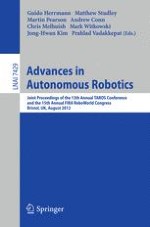2012 | OriginalPaper | Buchkapitel
Towards a Bio-inspired Cognitive Architecture for Short-Term Memory in Humanoid Robots
verfasst von : Fabio Ruini, Jens K. Apel, Anthony F. Morse, Angelo Cangelosi, Rob Ellis, Jeremy Goslin, Martin H. Fischer
Erschienen in: Advances in Autonomous Robotics
Verlag: Springer Berlin Heidelberg
Aktivieren Sie unsere intelligente Suche, um passende Fachinhalte oder Patente zu finden.
Wählen Sie Textabschnitte aus um mit Künstlicher Intelligenz passenden Patente zu finden. powered by
Markieren Sie Textabschnitte, um KI-gestützt weitere passende Inhalte zu finden. powered by
Short-Term Memory (STM) is a crucial weapon in humans’ cognitive arsenal as it allows them to avoid a purely sensory-motor existence. Many theoretical models have been proposed over the years attempting to capture the essential mechanisms of STM. Amongst these, one of the most prominent is the “Multi-Store Model” proposed by Atkinson and Shiffrin [1], later extended into the “Search of Associative Memory” model [2]. Replicating STM capabilities on a robotic platform is not a challenging issue if we just look at it as a mechanism to store information for the time needed to perform a certain task. Rather, more interesting is to investigate how to provide a robot with such feature in a simple and biologically-inspired fashion. The literature does not abound of examples on the topic, with the few exceptions of the researches of Gallagher [3], Wang [4], and Alan [5], whose models do not seem to account in a plausible way for the mechanisms we see at work in human beings.
The work we are presenting attempts to recreate STM capability in a bio-inspired fashion on the iCub robot. We took inspiration from psychological experiments carried out by Apel
et al.
[6], who investigated the role played by ocular movements during the memorisation of complex instruction sequences. Sit in front of a computer screen displaying a 3-by-3 numbered grid surrounded by 8 coloured objects, participants were presented with multicomponent instructions like “
Move the mug
[critical object]
to square 5
[goal square].” After attending to all the instruction components the subjects had to replay the sequence in the correct order, moving the objects using a mouse. Apel and colleagues found that participants often exhibit an “ocular rehearsal behaviour”,
i.e.
, they often tend to visually retrace the entire sequence when presented with new instructions. Such behaviour seems to have a positive impact on their likelihood in succeeding in the task.
Moving from these consideration we designed a cognitive architecture to replicate the observed behaviour in a replica of Apel’s experiment. The architecture relies upon a network of three interacting Self-Organising Maps (SOMs), similar to the one studied by Morse
et al.
[7]. Its topology consists on 3 SOMs respectively encoding: (A) robot’s eyes position; (B) critical object names, (C) goal square names. SOM A maps the position of the robot’s eyes according to two degrees of freedom; SOMs B and C work on the basis of the auditory footprints associated to the names of the critical objects and of the goal squares respectively.
Teaching the architecture how to deal with the task requires going through a sequence of stages. First, SOMs are exposed to samples of the future input in order to get “acquainted” with the range of data they will be experiencing during the experiment. Then the robot learns the names of objects and squares and how to look at them. This is done by making the robot looking at all the items in sequence (with a “virtual instructor” pronouncing the name of the current target) and creating bi-directional connections between the Best-Matching Units (BMUs) in SOM A and the corresponding ones in SOM B or C. Now the virtual instructor can generate a sequence of instructions and read each of them out loudly. The activation level of every unit in SOMs B and C is initially set to 0. As soon as a critical object or goal square is named the BMU corresponding to this item increases its activation level. Furthermore, the robot continuously fixate the various items in the scene according to a “fixation table” extrapolated from Apel’s experiment. These fixations contribute to modify the activation levels of units in SOMs B and C. These activations decrease over time unless being reinforced. At the end of the experiment the robot is left with a certain level of activation for each unit in SOMs B and C. The iCub counts how many units in each SOM have a positive activation, and the smallest between these two becomes the number of executions the robot will attempt. The execution itself is done selecting pairs of objects/squares depending on the activation levels of the corresponding SOM units, from the biggest to the smallest.
The results obtained so far, although not definitive, suggest that the architecture described herein can recreate the behaviour exhibited by the participants in Apel’s experiment and therefore similar performances.
